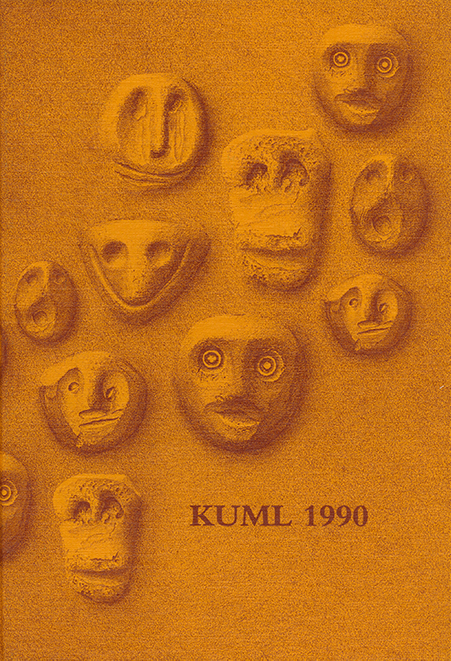The pair of lurs from Ulvkær, north Jutland
Pollen analysis of peat samples from the Ulvkær lurs
DOI:
https://doi.org/10.7146/kuml.v37i37.111166Keywords:
Lur, ulvkær, north jutland, pollen analysisAbstract
Pollen analysis of peat samples from the Ulvkær lurs
The Natural Science Research Unit of the National Museum was asked in 1988 to carry out a pollen-analytical examination of the two lurs from Ulvkær, which had been handed to the National Museum from Vendsyssel Historical Museum as treasure trove.
Peat samples were extracted from both of the lurs in 1988 and examined in 1990 by the author.
Analysis no. 1: Peat from the interior of tube fragment 4 of lur 1 (M 50447)
The pollen spectrum is dominated by tree pollen (62%). Of this alder made up 38.5%, birch 6.8%, hazel 3.7%, oak 6.2%, lime 1.9%, elm 0.6%, and pine 4.3%.
There was no pollen of shrubs or dwarf shrubs.
The herbaceous pollen is characterized by ferns (24.8%) and grasses (6.2%). There were also found pollen of sedges (1.9%), bracken (1.2%), knotgrass (0.6%), meadow-sweet (1.9%), and lesser club-mosses (0.6%).
Only a small number of brown coloured fungal hyphae was found, and no charcoal.
The material examined may be regarded as deriving from its original place of deposition, and there is nothing to suggest contamination with secondary material.
The sample is of wood peat with a large content of woody material, which is seen in the pollen slide. Also the pollen composition indicates an origin in a wooded area dominated by alder. Birch and oak certainly also grew in the alder-carr. The ground cover was characterized by ferns interspersed with grasses, sedges, and meadow-sweet.
The dominant position of alder shows chat the water table was high but water did not come to the surface.
Sheep's sorrel and knotgrass grow on dry land, and pollen of these plants must have been brought by the wind from outside the wooded mire.
A single spore of lesser club-moss was found, a plant which does not belong in the alder-carr. The species now grows on wet moorland, saline pastures, in hollows between sand dunes, and in lime-rich fens. It must therefore come from the surrounding area, in which one or more of the above biotopes could be found.
Many pollen grains show signs of corrosion, which together with the character of the pollen flora suggests nutrient-rich conditions at the point of deposition.
Analysis no. 2: Peat from inside tube fragment 6 of lur 2 (M 50456)
The pollen spectrum is dominated by tree pollen (55%). Of this alder makes up 32%, birch 11%, hazel 5%, lime 1%, oak 2%, ash 0.5%, and rowan 0.5%.
The shrub and dwarf shrub flora is represented by willow (0.5%), bog myrtle (0.5%) and heather (0.5%).
The herbaceous pollen composition is characterized by ferns (26%), grasses (8%), and sedges (4%). There were also pollen or spores of bracken (1.2%), sheep's sorrel (1.7%), ribwort plantain (0.3%), meadow sweet (0.6%), meadow rue (0.3%), bedstraw type (0.3%), stag's horn moss (0.3%), beech fern (0.3%), and bogbean (0.8%).
About half the tree pollen examined was to a greater or lesser degree corroded.
The material examined may be presumed to derive from its original place of deposition, and there is nothing to suggest chat there was admixture of secondary material.
The material examined is a wood peat with a large content of woody material. The pollen composition shows chat the sample is from a wooded area where alder and birch were the dominant tree species. The ground cover in the somewhat open wood was dominated by ferns mixed with grasses and sedges. The presence of bogbean shows chat the water level was high, and pools were undoubtedly present. The pollen/spores of bracken, sheep's sorrel, and ribwort plantain must have been blown in from dry soil areas outside the alder-carr, while the rest of the pollen types could derive from the local flora.
For the same reason as mentioned with analysis no. 1, the local vegetation must have been growing under nutrient-rich conditions.
Summary
The pollen spectra in the samples from lurs 1 and 2 are dominated by alder, birch, and ferns, and show so many points of similarity chat the peat could have formed under more or less identical conditions and in the same type of biotope, which can be described as an open alder-carr. However the analyses suggest chat the water level was higher where parts of lur 2 Jay than where those of lur 1 did.
Bent Aaby
Downloads
Published
How to Cite
Issue
Section
License
Fra og med årgang 2022 er artikler udgivet i Kuml med en licens fra Creative Commons (CC BY-NC-SA 4.0).
Alle tidligere årgange af tidsskriftet er ikke udgivet med en licens fra Creative Commons.


